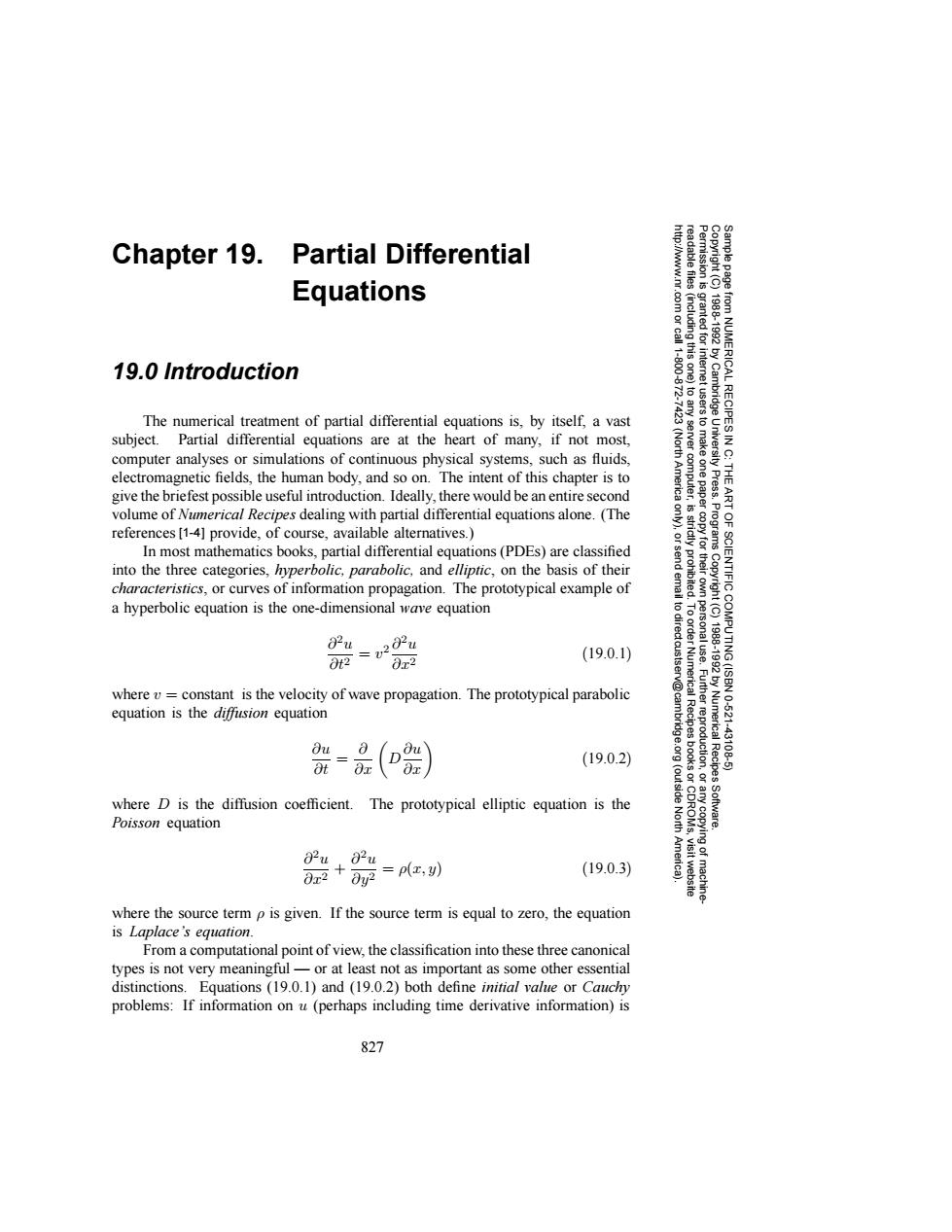正在加载图片...

Chapter 19.Partial Differential Equations .com or call 19.0 Introduction 11-800-72 Cambridge The numerical treatment of partial differential equations is,by itself,a vast NUMERICAL RECIPES IN subject.Partial differential equations are at the heart of many,if not most, server computer analyses or simulations of continuous physical systems,such as fluids, electromagnetic fields,the human body,and so on.The intent of this chapter is to compu give the briefest possible useful introduction.Ideally,there would be an entire second Press C:THEA volume of Numerical Recipes dealing with partial differential equations alone.(The 号 references [1-4]provide,of course,available alternatives.) g In most mathematics books,partial differential equations(PDEs)are classified into the three categories,hyperbolic,parabolic,and elliptic,on the basis of their SCIENTIFIC characteristics,or curves of information propagation.The prototypical example of a hyperbolic equation is the one-dimensional wave equation 6 02u 品 19.0.1) COMPUTING 1189-19 0x2 where v =constant is the velocity of wave propagation.The prototypical parabolic rica Furthe equation is the diffusion equation Recipes SBN0-6211 Ou du D t (19.0.2) (outside where D is the diffusion coefficient. The prototypical elliptic equation is the Poisson equation Software. 02u,02u 02+0n2 =p(x,) (19.0.3) America) visit website machine- where the source term p is given.If the source term is equal to zero,the equation is Laplace's equation. From a computational point of view,the classification into these three canonical types is not very meaningful-or at least not as important as some other essential distinctions.Equations (19.0.1)and (19.0.2)both define initial value or Cauchy problems:If information on u(perhaps including time derivative information)is 827Permission is granted for internet users to make one paper copy for their own personal use. Further reproduction, or any copyin Copyright (C) 1988-1992 by Cambridge University Press. Programs Copyright (C) 1988-1992 by Numerical Recipes Software. Sample page from NUMERICAL RECIPES IN C: THE ART OF SCIENTIFIC COMPUTING (ISBN 0-521-43108-5) g of machinereadable files (including this one) to any server computer, is strictly prohibited. To order Numerical Recipes books or CDROMs, visit website http://www.nr.com or call 1-800-872-7423 (North America only), or send email to directcustserv@cambridge.org (outside North America). Chapter 19. Partial Differential Equations 19.0 Introduction The numerical treatment of partial differential equations is, by itself, a vast subject. Partial differential equations are at the heart of many, if not most, computer analyses or simulations of continuous physical systems, such as fluids, electromagnetic fields, the human body, and so on. The intent of this chapter is to give the briefest possible useful introduction. Ideally, there would be an entire second volume of Numerical Recipes dealing with partial differential equations alone. (The references [1-4] provide, of course, available alternatives.) In most mathematics books, partial differential equations (PDEs) are classified into the three categories, hyperbolic, parabolic, and elliptic, on the basis of their characteristics, or curves of information propagation. The prototypical example of a hyperbolic equation is the one-dimensional wave equation ∂2u ∂t2 = v2 ∂2u ∂x2 (19.0.1) where v = constant is the velocity of wave propagation. The prototypical parabolic equation is the diffusion equation ∂u ∂t = ∂ ∂x D ∂u ∂x (19.0.2) where D is the diffusion coefficient. The prototypical elliptic equation is the Poisson equation ∂2u ∂x2 + ∂2u ∂y2 = ρ(x, y) (19.0.3) where the source term ρ is given. If the source term is equal to zero, the equation is Laplace’s equation. From a computational point of view, the classification into these three canonical types is not very meaningful — or at least not as important as some other essential distinctions. Equations (19.0.1) and (19.0.2) both define initial value or Cauchy problems: If information on u (perhaps including time derivative information) is 827�